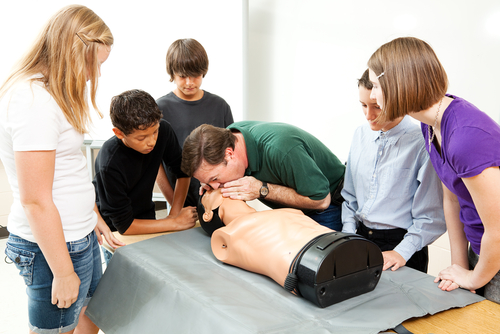
Considering careers in public health? Public health is one of the leading health care areas seeing tremendous growth and promise. The Bureau of Labor Statistics expects public health education jobs to jump 11 percent from 2018 to 2028. Public health administration will experience much faster-than-average job growth of 18 percent. Biostatistics is perhaps the hottest public health specialization with a whopping 30 percent growth outlook this decade. In early 2020, the National Institutes of Health (NIH) warned of a dire shortage of 250,000 public health professionals. Without proper public health staffing, America is at risk for disastrous disease spread. Public health careers focus on bettering societal wellness by promoting healthy behaviors and reducing community health disparities. Prospective college students with the caring gene can use the following guide to determine if public health is their perfect match.
Related resource: Top 25 Online MPH Programs (Master’s in Public Health)
What are Public Health Professionals?
The Association of Schools and Programs of Public Health (ASPPH) defines public health as the sector for protecting the well-being of diverse populations locally or globally. Public health professionals are highly trained workers who improve health outcomes on a community level. Unlike doctors and nurses who treat individual patients, public health practitioners develop initiatives to treat greater humankind. Public health careers are centered on preventing disease and injury for healthier, longer lives. Public health is a broad umbrella term to cover all professionals advocating for community wellness. Most public health practitioners specialize their skills in addressing a certain population. For example, public health staff could work with refugees, senior citizens, people with disabilities, trauma victims, or premature infants. Public health initiatives could target diverse medical issues, such as HIV/AIDs, smoking, diabetes, opioid addiction, or breast cancer.
 Public health professionals implement educational programs to correct harmful, life-threatening behaviors. Public health workers develop policies to advance a more equitable medical industry. Public health practitioners administer social services, such as STD testing, workplace assessments, and low-cost vaccines. Many public health jobs involve conducting research to better understand the roots of illnesses and clinical treatments. Public health workers regulate and coordinate effective medical systems for outstanding patient care. Public health professionals mobilize response teams for outbreaks and natural disasters. Public health workers enforce occupational regulations that keep employees safe on the job. Careers in public health are diverse, yet similar in their big contribution to health care improvement. People who want to make a lasting impact on the planet should consider a public health degree.
Public health professionals implement educational programs to correct harmful, life-threatening behaviors. Public health workers develop policies to advance a more equitable medical industry. Public health practitioners administer social services, such as STD testing, workplace assessments, and low-cost vaccines. Many public health jobs involve conducting research to better understand the roots of illnesses and clinical treatments. Public health workers regulate and coordinate effective medical systems for outstanding patient care. Public health professionals mobilize response teams for outbreaks and natural disasters. Public health workers enforce occupational regulations that keep employees safe on the job. Careers in public health are diverse, yet similar in their big contribution to health care improvement. People who want to make a lasting impact on the planet should consider a public health degree.
10 Greatest Public Health Achievements
For those with a strong desire to help others, public health careers can be one of the best avenues to fulfill that need. Since ancient times, public health practitioners have advanced the quality of life for entire populations throughout history. In the 1340s, early public health workers developed protocols for controlling the Black Death. In 1754, James Lind notably discovered the cause of scurvy to protect thousands of sailors and explorers. In 1848, Britain passed the Public Health Act to implement new sanitation strategies. Twenty years later, the New York City Health Department became the first such U.S. Agency. Since 1900, the average age lifespan for Americans has risen 30 years, of which 25 years are attributed to public health changes. In 1999, the Centers for Disease Control (CDC) identified these as the 10 greatest public health achievements of the 20th century.

- Vaccinations – Public health professionals have devised, tested, and distributed vaccines to immunize against 21 once-common diseases. Mortality rates for most of these vaccine-preventable diseases have dropped 100 percent. For example, the United States had an annual average of 48,164 smallpox cases in the early 1900s. By 1977, the public health field entirely eradicated smallpox with Edward Jenner’s vaccine. Public health workers have defeated polio, diphtheria, typhoid, cholera, rabies, and more with vaccine development.
- Motor Vehicle Safety – Though modern cars were invented in 1886 by German innovator Karl Benz, few people drove at the start of the 20th century. From 1920 to 2000, the number of U.S. motor vehicles skyrocketed to 215 million. Nonetheless, the death rate from car accidents dropped 90 percent in that time period. Public health workers advocated for motor vehicle safety features, including seatbelts, airbags, and child car seats. The public health field has gotten protective legislation like the 1966 Highway Safety Act passed.
- Workplace Safety – Bad labor practices in the early-20th century made workplaces dangerous. In 1907 alone, there were 2,534 fatal on-the-job incidents at coal mines. In 1912, the National Safety Council counted 21,000 work-related deaths nationwide. Public health pioneers like Dr. Alice Hamilton formed initiatives that save employees’ lives. Public health workers instituted OSHA for protections like respirators, machine guards, scaffolds, and fall-proof harnesses. By 1997, the occurrence of occupational injuries dropped 90 percent.
- Infectious Disease Control – Besides vaccines, public health leaders have founded countless disease control methods. In 1910, the public health field developed serologic testing to track syphilis spread. In 1925, public health professionals ended the last U.S. rat-associated plague. In 1928, Alexander Fleming discovered the antibiotic penicillin to cure bacterial infections. Revolutionary changes were made to food handling, waste disposal, and personal hygiene. Deaths from infectious diseases dropped from 797 to 36 per 100,000 people.
- Decline in Cardiovascular Disease Deaths – Since 1921, heart disease has been America’s #1 most deadly killer. Though heart disease and stroke still pose a risk, the number of victims has decreased. Cardiovascular disease deaths are 60 percent lower today. Public health professionals have made strides by teaching heart-healthy choices like diet and exercise. In 1999, more people with hypertension had their blood pressure under control. Public health workers have also established initiatives like the National Cholesterol Education Program.
- Food Safety – During the 1940s, 16 percent of U.S. adults had a foodborne parasitic infection called trichinellosis. Rates of typhoid fever from contaminated food were 100 per 100,000 people. Thanks to public health efforts, food-related illnesses have plummeted to 1.7 per 100,000. Public health practitioners have introduced food safety protocol for meat production, milk pasteurization, pesticide use, and crop harvesting. Public health workers have controlled several outbreaks of salmonella, listeria, botulism, E. coli, and others.
- Maternal and Child Health – From 1900 to 1930, the United States had its highest mortality rate for pregnant women. The public health field achieved an inspiring 99 percent decline in maternal deaths by 1999. Public health practitioners addressed delivery issues like sepsis, hemorrhage, and pre-eclampsia. Similarly, America’s infant mortality rate was reduced by 90 percent. In 1900, nearly one-third of newborn babies died. Public health workers advanced ways to lessen mortality risks from birth defects, low birth weight, SIDS, and injuries.
- Family Planning – Public health has made remarkable family planning strides to promote women’s well-being and socioeconomic opportunity. The average family size dropped from 7.0 to 2.3 children during the 20th century. In 1912, sex educator Margaret Sanger started the birth control movement. In 1916, Planned Parenthood was founded in Brownsville, New York, to provide contraception. Public abstinence programs have made teen pregnancies drop 70 percent. Even before Roe v. Wade, public health workers advocated for safe alternatives to back-alley abortions too.
- Drinking-Water Fluoridation – In 1901, public health pioneer Dr. Frederick McKay first linked drinking water to oral cavities. Bacteria, such as Streptococcus mutants, was eroding Americans’ tooth enamel. In 1931, the National Institutes of Health (NIH) developed the Dental Hygiene Unit for a solution. By 1942, fluorosis showed significant results in preventing cavities. In tested regions, the prevalence of dental cavities declined by up to 70 percent. Public health practitioners got fluoridation systems installed in 10,567 localities with over 135 million residents. Fewer cavities lowers the risk of periodontitis or gum disease and tooth loss.
- Tobacco Use Reduction – At the start of the 20th century, smoking was a widespread social behavior. As tobacco use soared, so did the rate of lung cancer and smoking-related diseases. Public health practitioners convinced the U.S. Surgeon General to label smoking a health hazard in 1964. Three years later, the Action on Smoking & Health (ASH) was launched. From 1965 to 1997, the percentage of adults who smoked fell from 42.4 to 24.7. Yearly cigarette consumption declined from 4,345 to 2,261 per capita. The public health field keeps advocating for tobacco control and lung health.
From 2000 to today, our rapidly changing health care delivery system has placed greater emphasis on health promotion. On March 23, 2010, President Obama signed the Affordable Care Act that gave more than 20 million U.S. residents health insurance. Access to disease prevention tools, including screening tests, will likely reduce diagnoses. That said, America is still fighting significant public health battles. As of June 2020, the country is suffering a coronavirus pandemic with 2.03 million confirmed cases. The State of Childhood Obesity reports that 18.5 percent of kids are severely overweight. The Kaiser Family Foundation calculated a drug overdose death rate of 20.7 per 100,000 people. The World Health Organization (WHO) estimates that 31 percent of adults lead sedentary lifestyles. From air pollution to food insecurity, there are numerous public health challenges left to address.
Introduction to the Careers in Public Health
Want to leave a mark on 21st-century public health history? New public health practitioners can make population-based health improvements in the coming decades. Public health careers are divided into five core disciplines. First, epidemiology is the public health branch concerned with studying the incidence and spread of dangerous diseases. Second, biostatistics is the public health field that focuses on compiling research data from clinical trials and experiments. Health policy and management is the public health segment that emphasizes the delivery of quality, affordable medical care. Social and behavioral health is the public health category that centers on educating community members about wellness habits. Environmental and occupational health is the last public health field that protects people from everyday hazards around them. In each discipline, there are many public health jobs in sectors from government to pharmaceutical manufacturing. Let’s explore some examples of in-demand career titles.

- Health Education Specialist – Health education specialists are community leaders who develop initiatives to inform people about disease risks. Health education specialists design training workshops, seminars, events, pamphlets, ad campaigns, online videos, and more to build awareness. Health education specialists aim to reduce premature death by changing people’s lifestyles and preventing maladies. Health education specialists also ensure at-risk populations have resources like insurance, contraception, and blood pressure monitors. Becoming a Certified Health Education Specialist (CHES) requires passing a 165-question, three-hour test.
- Disease Ecologist – Disease ecologists are public health scientists who trace patterns to determine how infectious diseases evolve over time. Disease ecologists study the methods of contagion to identify how pathogen mechanisms work to infect hosts. Disease ecologists utilize statistical methods to forecast the scale at which illnesses will impact certain populations or whole ecosystems. Disease ecologists often research both human and animal diseases, such as tuberculosis, malaria, cellulitis, and gonorrhea. Disease ecologists also investigate cases in which infectious pathogens become drug-resistant.
- Nursing Home Administrator – Nursing home administrators are licensed geriatric services managers who oversee the day-to-day operations of assisted living sites. Nursing home administrators hire and supervise a competent medical staff for treating senior citizen residents with dignity. Nursing home administrators strive to build a positive, caring climate that enhances the welfare of older adults. Nursing home administrators double-check that their facilities exceed legal regulations and stay on a spending budget. Nursing home administrators must respond expeditiously when infectious disease outbreaks threaten the elderly population.
- Genetic Counselor – Genetic counselors are public health biotechnologists who utilize DNA tests to determine people’s risks for inherited diseases. Genetic counselors work at diagnostic labs to give patients information about the genetic markers for conditions like Huntington’s disease, Marfan syndrome, Alzheimer’s, and sickle cell anemia. Genetic counselors can even safely extract amniotic fluid from the placenta to determine fetal health and find birth defects. Genetic counselors spend considerable time educating families about their health risks. Teaching people how to cope with likely disease developments is their mission.
- Public Health Lawyer – Public health lawyers are board-certified attorneys who examine government legislation that impacts community welfare. Public health lawyers advocate on behalf of clients who feel their legal rights concerning health were violated. Public health lawyers pore over law statutes to determine if legal matters have the merit for court. Public health lawyers then argue cases in front of judges to ensure clients receive the justice they deserve under the Constitution. Public health lawyers sometimes conduct scholarly research, develop law school curricula, and publish analyses in legal journals. Attending a Dual Master of Public Health/Juris Doctor program is the best bet for Bar Exam prep.
- Wellness Coordinator – Wellness coordinators are corporate health enthusiasts who work to better employees’ physical, mental, and emotional well-being. Wellness coordinators develop company-wide initiatives to engage workers in health promotion activities. Wellness coordinators draft innovative ideas for getting employees active and more productive. Wellness coordinators could create an office gym, lead exercise groups, hire an on-site yoga instructor, and develop nutritious cafeteria menus. Wellness coordinators track the effectiveness of their health education tactics and make changes to retain the organization’s happy, healthy talent.
- Public Health Engineer – Public health engineers are creative problem-solvers who design new tools for preventing or coping with human diseases. Public health engineers create blueprints for innovative equipment that promotes community wellness. Public health engineers might create sanitation systems, water filters, assistive technologies, or medical scanners. Public health engineers must brainstorm, sketch prototypes, oversee manufacturing, and test product performance. Public health engineers are STEM professionals with technical and clinical knowledge to resolve everyday life issues.
What is the salary potential for public health careers? Depending on the job, public health practitioners can reap both intrinsic and monetary rewards. In May 2019, the U.S. Department of Labor recorded an average yearly wage of $60,500 for health education specialists. Community health workers received a mean annual income of $44,390. Occupational health and safety specialists had median earnings of $76,290. Environmental health specialists had an average compensation of $77,940. Epidemiologists made a mean annual wage of $78,290. Medical scientists were given a median salary of $98,770. Food safety technologists collected an average yearly paycheck of $76,190. Nutritionists earned mean annual profits of $62,330. Emergency management directors reported a median income of $82,530. Medical and health services managers had an average yearly rate of $115,160. Community service managers were awarded a mean pay of $72,900. Public health professors had a median contract price of $112,850.
Degree Options in Public Health

How can prospective public health workers get their start? Becoming a public health practitioner requires spending at least 48 months in college. Four-year bachelor’s degrees are the customary bare minimum requirement for public health careers. Public health associate degrees are only intended for a 2+2 transfer pathway to universities. Most public health positions call for a master’s degree or higher. Many public health practitioners enter graduate school with a different major, such as nursing, social work, or psychology. Graduate public health programs ensure students have a strong work ethic, compassion, and problem-solving skills to practice. Master’s degrees in public health shape a leadership mentality for upper-level jobs too. For those looking at colleges and universities with degrees in public health, there is a wide variety of options. Here’s an overview of common degrees pursued in public health.
- Bachelor of Science in Public Health (BSPH) – The Bachelor of Science in Public Health is the entry-level, undergraduate degree for freshmen to build foundational knowledge. Getting this degree takes at least four years unless it’s an Accelerated 3+1 BSPH/MPH option. The 120-credit BSPH curriculum starts with general education courses in academic subjects from writing to world history. BSPH majors start upper-division courses, such as Introductory Public Health and Health Promotion, in the junior year. Most Bachelor of Science in Public Health tracks integrate 200-400 fieldwork hours and a senior capstone project.
- Master of Public Health (MPH) – The Master of Public Health is the terminal, professional-level degree for graduate students to enter independent practice. Finishing this program usually takes 12 to 36 months unless it’s a Dual MPH option for two degrees. The standard MPH curriculum has 36 to 48 credits of courses at the 500 or higher level. MPH majors dive into all five core disciplines with courses like Environmental Health and Epidemiology. Second-year students can elect for MPH specializations or generalist, thesis-optional tracks. Accredited Master of Public Health degrees generally require 180-600 practicum hours.
- Master of Health Administration (MHA) – The Master of Health Administration is a specialized, graduate-level management degree for seeking clinical leadership careers. Earning this degree typically entails 30 to 60 credits of public health and business courses. MHA majors spend 12 to 36 months in classes like Health Care Economics and Organizational Behavior. Executive MHAs could conclude in as little as nine months on-campus or online. Master of Health Administration curricula almost always requires a semester-long internship residency. MHA capstone projects replace the traditional thesis for case studies and consulting work.
- Master of Science in Public Health (MSPH) – The Master of Science in Public Health is a technical, research-based alternative for graduates interested in laboratory work. Unlike the MPH, this degree has a more theoretical than a practical framework. Achieving an MSPH degree normally takes at least 18 months for 36+ credits beyond a bachelor’s. MSPH curricula blend hands-on research assistantships with scientific courses like Biostatistical Methods and Econometrics. MSPH majors work one-on-one with thesis advisors to undertake original research. The Master of Science in Public Health offers stronger preparation for a future doctorate.
- Doctor of Philosophy in Public Health (PhD) – The Doctor of Philosophy in Public Health is the highest, research-oriented graduate degree for scholars and medical scientists. Getting a PhD prepares candidates for tenured faculty roles teaching and researching in academia. Completing a PhD in Public Health requires at least 90 post-bachelor’s credits. Individuals with a master’s degree could need as little as 36 credits. The PhD timeline of three to seven years includes graduate seminars, assistantships, field practicum, and research. Every PhD candidate must create and defend a doctoral dissertation paper of 150+ pages.
- Doctor of Public Health (DrPH) The Doctor of Public Health is the most advanced, practice-oriented graduate degree for industry leaders in academia or the field. Pursuing this degree requires finishing an MPH or close equivalent first. Most DrPH build atop that foundation with 45-70 credits in a customized practice specialization. DrPH curricula last 2.5 to five years for courses like Bioethics and Policy Planning. DrPH majors aim for the field’s highest supervisory roles, such as Chief Public Health Officer. Seminars lead to qualifying exams and year-long internships. Many DrPH programs require less research than the standard PhD dissertation.
Students can additionally choose from over 20 fields of study for public health concentrations. Declaring a public health specialization lets students expand beyond the five core disciplines already described. For example, global health is a broad subfield that trains public health professionals to work abroad and solve international issues. Maternal and child health is a branch where public health workers give pregnant women the resources to have healthy babies. Nutrition is a popular public health concentration that focuses on making dietary plans of wholesome, yet delicious foods. Infectious diseases is another subfield where public health students learn how to utilize vaccines and antibiotics to slow disease spread. Informatics is a new public health specialization aimed at using technological data systems to enhance health outcomes. Emergency management is a public health discipline for mitigating the medical threats of natural and man-made disasters. Peruse the Council for Education in Public Health (CEPH) directory for accredited programs in any desired specialization.
Overall, public health careers are growing fast to keep progressing America’s life expectancy. Public health students can follow in the footsteps of historic pioneers who solved deadly health calamities and epidemics. Getting certified by the National Board of Public Health Examiners (NBPHE) could help. Employers increasingly look for the Certified in Public Health credential. The certification requires having at least a bachelor’s degree and five years of work experience. Graduates of CEPH-accredited graduate programs qualify with only fieldwork experience. The $385 Certified in Public Health exam has a 200-question, four-hour format. Since 2012, the national pass rate has exceeded 75 percent. Takers are tested on 10 domain areas, including health equity and human disease risk. Once certified, professionals must abide by the CPH Code of Ethics and document 50+ continuing education credits biennially. Certified individuals prove their know-how and skills to pursue a career in public health.
Related Resources:
- Top 25 Most Affordable Online Master’s in Public Health
- Top 25 Online MPH Programs
- Top 35 Schools for a Graduate Degree in Public Health
- Top 50 Masters in Public Health Online
- What is the Accreditation I Should Look For in a School of Public Health?
- What is the Curriculum for a Master of Public Health Degree?
- What is the Difference Between a Master of Public Health and a Master of Health Administration?
- What is the Difference Between an MS in Public Health and an MS in Healthcare Management?
- What is the Desired Educational Level for a Public Health Career?